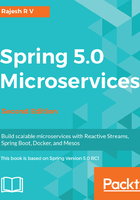
Microservices are lightweight
Well-designed microservices are aligned to a single business capability; therefore, they perform only one function. As a result, one of the common characteristics we see in most of the implementations are microservices with smaller footprints.
When selecting supporting technologies, such as web containers, we will have to ensure that they are also lightweight so that the overall footprint remains manageable. For example, Jetty or Tomcat are better choices as application containers for microservices as compared to more complex traditional application servers, such as Weblogic or WebSphere.
Container technologies such as Docker also helps us keep the infrastructure footprint as minimal as possible compared to hypervisors such as VMware or Hyper-V.

As shown in the preceding diagram, microservices are typically deployed in Docker containers, which encapsulate the business logic and needed libraries. This helps us quickly replicate the entire setup on a new machine, a completely different hosting environment, or even move across different cloud providers. Since there is no physical infrastructure dependency, containerized microservices are easily portable.